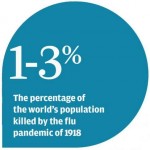 Controversial experiments, using an artificial but deadly strain of bird flu, to return after scientists agree to follow strict new biosecurity guidelines
Controversial experiments, using an artificial but deadly strain of bird flu, to return after scientists agree to follow strict new biosecurity guidelines
Experiments with a deadly, artificially mutated version of the bird flu virus are set to resume in a few weeks, ending a year-long suspension in research prompted by a global outcry over the risks.
Two groups of scientists in the Netherlands and the US altered the H5N1 virus to make it easily transmissible among mammals. Some scientists warned that a deadly pandemic could break out if the mutant virus escaped accidentally or if terrorists stole it or made it themselves, using articles in scientific journals.
The outcry led scientists conducting the experiments to declare a voluntary moratorium a year ago, in part to let research institutes and governments decide what safety rules to require.
Now, flu researchers say, the moratorium should end because most countries have rules in place. A letter from the same 40 scientists who called for the moratorium last year was published yesterday in the journals Science and Nature, saying it is time for the work to begin again in countries ready to allow it. Signatories include Hong Kong researchers Guan Yi and Malik Peiris.
Leo Poon Lit-man, associate professor at the University of Hong Kong’s school of public health, said the university had no plans so far for research to make the bird flu virus stronger or more transmissible. He said a group of researchers signed the letter as a gesture to support the controversial research.
“The only way … to control the virus and come to a prevention plan is to allow the research to go forward,” Poon said. Though he has not signed the letter himself, he spoke on behalf of the research team that supported the move, including researchers Yi and Peiris.
“The issue is highly controversial and we understand different people hold different points of view. H5N1 is still a threat to humans, and it is true that the research may pose some risk. But we may also benefit from it, as we need further understanding of the virus to ensure a better response in case of an outbreak.
“We think it is time to draw a conclusion that the research has to go on,” Poon said.
Researchers will restart projects in countries where governments have approved biosecurity measures, according to the letter signed by 40 researchers. This does not currently include the US, the scientists wrote.
The US is expected to approve its own rules for dealing with the mutant virus within weeks.
Ron Fouchier, a virologist who conducted some of the original experiments at the Erasmus Medical Centre in the Netherlands, said research was needed to test the effectiveness of vaccines and antiviral medications against a mutated virus that could be spread by mammals.
The first cases of H5N1 emerged in Hong Kong in 1997, setting off alarm bells worldwide. Six of the 18 victims died. It re-emerged in 2003 in Southeast Asia and other countries, infecting some 600 with a mortality rate of almost 60 per cent, according to the Geneva-based WHO.
All but a few victims have caught the disease from birds. Scientists’ worst fear is the virus spreading among mammals.
Source: South China Morning Post

















